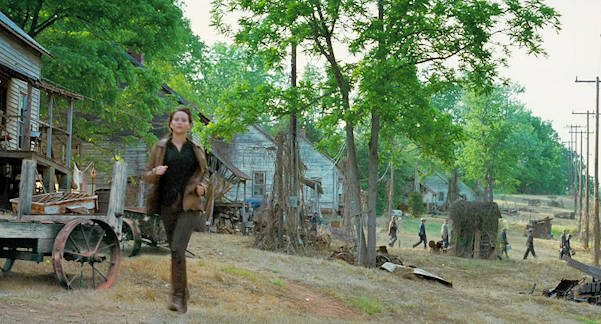The Reality of the Games
Within the Hunger Games, it becomes very obvious the state of oppression the citizens of Panem are being subjected to beneath the gaze of the Capitol. This cultural hegemony is partially due to the panoptic surveillance that the Capitol enforces. And while the Capitol relies on surveillance as a strategy to promote and maintain control over the citizens of Panem, they are able to strengthen its effectiveness by associating disobedience with sovereign power and violence (Connors).




An image of the Capitol of Panem in all of its glory.
And if we look even closer at the effectiveness of the surveillance and its ability to manipulate the public, we're able to notice a distinction between the rich and the poor Districts. However, effectiveness isn't directly related to wealth. Instead, it's related to technology.
Granted, the Districts with more money will be able to have access to more advanced technology, because they can afford it. Whereas in District 12, they're lucky if they have electricity and power.

An image of Katniss running through the streets of her home, District 12. There's an obvious difference in nature, environment, and technology when compared to that of the Capitol.
But back to the connection between technology, surveillance, and its effectiveness in manipulating the masses. Another thing to remember, is that all of the advanced technology being distributed to the Districts is being manufactured from within the Capitol. The Capitol is thus able to manipulate the public easier, first by making the new products seem appealing, and secondly, after citizens purchase the new products. They allow themselves to be manipulated in the first place, and the Capitol uses this to their advantage by using this same technology to spy on and control its subjects.
This is more evident in the movies when we see the Capitol for the first time. This link will take you on a somewhat interactive tour of the Capitol. While it gives a better perspective of inside the Capitol, it also exposes important aspects of technology and surveillance present within the Capitol as well.
For instance, when the tour is in the control room, we can see technology tracking the vitals and location of citizens within the Capitol. We also hear the tour guide announce that they can almost always monitor any citizen at any time. This plays back into the Capitol's use of panoptic surveillance. Whether or not they are constantly monitoring the citizens of Panem, all they have to do is make them think that they are. That, associated with fear of breaking the rules or showing signs of disrespect or disapproval against the Capitol, are an effective method of preventing rebellion.
So while the Capitol is associated with wealth and technology, Districts further from the Capitol, such as District 12, are associated with being poor. However, one thing that the poorer Districts have that the richer ones don't, is access to nature. For Katniss, nature is her safe place. When she's in the woods, she's away from all of the technology and politics of Panem. This is most evident at the end of the trilogy, when she moves back to District 12 after the rebellion. Since District 12 was bombed during the rebellion, it actually made it further removed from society and technology, allowing it to have a closer connection with nature. She isolates herself from the hegemony and manipulation of society, and surrounds herself with the security and freedom of untouched nature.

Katniss with Peeta and her children in District 12 after the rebellion against the Capitol, surrounded by nature.
Sources:
Connors, Sean P. The Politics of Panem. Sensepublishers, 2014.
Connors, Sean P. The Politics of Panem. Sensepublishers, 2014.
Comments
Post a Comment